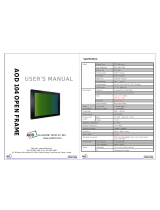Choose the RGB option if monitor is connected to a PC or a DVD using a VGA or DVI cable. Choose the YPbPr option if monitor is
connected to a DVD by a YPbPr to VGA or YPbPr to DVI cable or if the DVD color output setting is not RGB.
You can choose Graphics or Video according to the input signal. Select Graphics if connecting a PC to your monitor; for connecting
DVD, STB or VCR to your monitor, Video is recommended.
When you select Graphics, you can choose Standard, Multimedia, Game, Warm, Cool, or Custom (R,G,B);
l If you view media application like photo, clip etc via PC, choose "Multimedia" preset;
l If you play a game in PC, choose "Gaming" preset;
l If you prefer a lower color temperature (5700K), choose "Warm" preset;
l If you prefer a higher color temperature, choose "Cool" preset;
l Custom (R, G, B) Preset offers a range of 6500K colors;
l Choose "Standard" to utilize the panel native color format;
l Select Warm preset for a reddish tint. This color setting is used for color-intensive applications (photograph image editing,
multimedia, movies, etc.)
l Select Cool preset for a bluish tint. This color setting is used for text based applications (spreadsheets, programming, text
editors, etc.)
l
Select Custom preset to increase or decrease each of the three colors (R, G, B) independently, in single digit increments, from 0





















